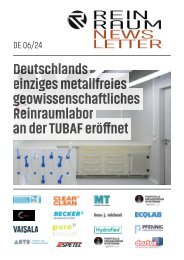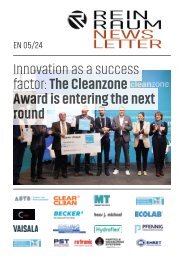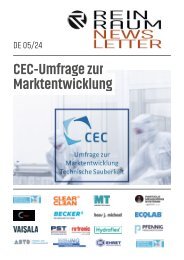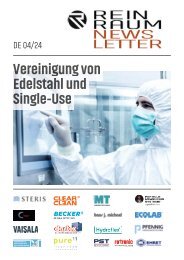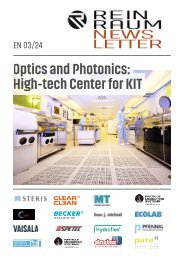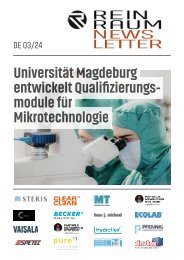Newsletter_07-2024_EN
You also want an ePaper? Increase the reach of your titles
YUMPU automatically turns print PDFs into web optimized ePapers that Google loves.
Interview by Cristina Masciola, AM Instruments<br />
– Marketing & Communication Manager<br />
Cleaning & Disinfection according to new<br />
Annex 1: An interview with Tim Sandle<br />
“For disinfection to be effective, prior cleaning to remove surface<br />
contamination should be performed. Cleaning programmes should<br />
effectively remove disinfectant residues. More than one type of disinfecting<br />
agent should be employed to ensure that where they have<br />
different modes of action, their combined usage is effective against<br />
bacteria and fungi. Disinfection should include the periodic use of a<br />
sporicidal agent.”<br />
Once again, we spoke to Tim Sandle, microbiologist, author and<br />
science journalist, known as one of the leading experts in the field,<br />
to discuss in the most appropriate way what challenges the pharmaceutical<br />
industry is facing in adapting cleaning & disinfection to the<br />
Annex 1 requirements.<br />
Rotation of disinfectants<br />
The latest version of Annex 1 adds in paragraph 4.33: “more than<br />
one type of disinfecting agent should be employed to ensure that<br />
where they have different modes of action, their combined usage<br />
is effective against bacteria and fungi”. Thus, it seems that more<br />
products effective against bacteria and fungi should be used in<br />
addition to a sporicidal agent. Is the two-product rotation (one<br />
bactericide/fungicide and one sporicide) – already in use by many<br />
pharmaceutical companies – acceptable?<br />
When cleanroom disinfectants are selected many users opt to<br />
select two or more disinfectants. If a sporicide is a regularly used<br />
agent, then two disinfectants should be sufficient.<br />
Rotation is important for several reasons:<br />
– Most disinfectants do not have a complete spectrum of activity<br />
effective against all microorganisms (spectrum of activity is the<br />
ability of the disinfectant to kill different types of microorganisms<br />
and microorganisms which are in different physiological states).<br />
The disinfectants commonly used are often effective against<br />
vegetative cells but are not sporicidal. To maintain an effective<br />
contamination control, the elimination of bacterial endospores<br />
through a sporicidal disinfectant is recommended (these are sometimes<br />
referred to as high-level disinfectants). Here a sporicide<br />
would be used in rotation with a non-sporicidal disinfectant.<br />
– The disinfectants with the formulations which are effective<br />
against the greatest range of microorganisms are often expensive.<br />
With this, many manufacturers use a general broad-spectrum<br />
disinfectant daily or weekly with a sporicidal disinfectant used<br />
weekly or monthly (a decision often based on the results of microbiological<br />
environmental monitoring and the characterization<br />
of the isolated microorganisms).<br />
– Some disinfectants, such as sporicides, are corrosive. While the<br />
risk to surfaces can be reduced through rinsing, rotation is sometimes<br />
undertaken in order to reduce the risk of damage to cleanroom<br />
equipment and working benches.<br />
– Rotating two disinfectants can also reduce the possibility of resistant<br />
strains of microorganisms developing. Whilst the phenomenon<br />
of microbial resistance is an issue of major concern for antibiotics<br />
there are few data to support development of resistance to<br />
disinfectant. Nonetheless, it remains a regulatory expectation.<br />
Thus, the reasons for rotation are approached from either a desire to<br />
widen the mode of action or to address anticipated regulatory concerns.<br />
Effective cleaning & disinfection<br />
Cleaning and disinfection affect floors, walls, ceilings, but also<br />
machinery and equipment, and often hard-to-reach surfaces.<br />
Which cleaning and disinfection methods are most effective in<br />
this respect?<br />
These depends on the circumstances, however good application<br />
techniques are important, for example with floor cleaning and disinfection:<br />
– Either roll all of the floor surface with a tacky roller to remove any<br />
loose debris and fibers, moving any equipment to one half of the<br />
room nearest exit door, or wipe the floor using a neutral detergent<br />
solution and mop and bucket.<br />
– Use a use disinfectant impregnated mop wipes and mops (alter-<br />
www.reinraum.de | www.cleanroom-online.com NEWSLETTER | Edition <strong>EN</strong> <strong>07</strong>-<strong>2024</strong><br />
page 4/28








